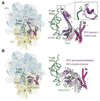Translational termination without a stop codon
- PMID: 27934701
- PMCID: PMC5351859
- DOI: 10.1126/science.aai9127
Translational termination without a stop codon
Abstract
Ribosomes stall when they encounter the end of messenger RNA (mRNA) without an in-frame stop codon. In bacteria, these "nonstop" complexes can be rescued by alternative ribosome-rescue factor A (ArfA). We used electron cryomicroscopy to determine structures of ArfA bound to the ribosome with 3'-truncated mRNA, at resolutions ranging from 3.0 to 3.4 angstroms. ArfA binds within the ribosomal mRNA channel and substitutes for the absent stop codon in the A site by specifically recruiting release factor 2 (RF2), initially in a compact preaccommodated state. A similar conformation of RF2 may occur on stop codons, suggesting a general mechanism for release-factor-mediated translational termination in which a conformational switch leads to peptide release only when the appropriate signal is present in the A site.
Copyright © 2016, American Association for the Advancement of Science.
Figures




Similar articles
-
Structural basis for ArfA-RF2-mediated translation termination on mRNAs lacking stop codons.Nature. 2017 Jan 26;541(7638):546-549. doi: 10.1038/nature20821. Epub 2016 Dec 1. Nature. 2017. PMID: 27906161
-
Structural basis of co-translational quality control by ArfA and RF2 bound to ribosome.Nature. 2017 Jan 26;541(7638):554-557. doi: 10.1038/nature21053. Epub 2017 Jan 11. Nature. 2017. PMID: 28077875 Free PMC article.
-
Mechanistic insights into the alternative translation termination by ArfA and RF2.Nature. 2017 Jan 26;541(7638):550-553. doi: 10.1038/nature20822. Epub 2016 Dec 1. Nature. 2017. PMID: 27906160
-
Structural aspects of translation termination on the ribosome.RNA. 2011 Aug;17(8):1409-21. doi: 10.1261/rna.2733411. Epub 2011 Jun 23. RNA. 2011. PMID: 21700725 Free PMC article. Review.
-
Recent advances in peptide chain termination.Mol Microbiol. 1990 Jun;4(6):861-5. doi: 10.1111/j.1365-2958.1990.tb00658.x. Mol Microbiol. 1990. PMID: 2215213 Free PMC article. Review.
Cited by
-
The structural basis for release-factor activation during translation termination revealed by time-resolved cryogenic electron microscopy.Nat Commun. 2019 Jun 12;10(1):2579. doi: 10.1038/s41467-019-10608-z. Nat Commun. 2019. PMID: 31189921 Free PMC article.
-
A unified dinucleotide alphabet describing both RNA and DNA structures.Nucleic Acids Res. 2020 Jun 19;48(11):6367-6381. doi: 10.1093/nar/gkaa383. Nucleic Acids Res. 2020. PMID: 32406923 Free PMC article.
-
In situ architecture of a nucleoid-associated biomolecular co-condensate that regulates bacterial cell division.Proc Natl Acad Sci U S A. 2025 Jan 7;122(1):e2419610121. doi: 10.1073/pnas.2419610121. Epub 2024 Dec 31. Proc Natl Acad Sci U S A. 2025. PMID: 39739804 Free PMC article.
-
Controlling orthogonal ribosome subunit interactions enables evolution of new function.Nature. 2018 Dec;564(7736):444-448. doi: 10.1038/s41586-018-0773-z. Epub 2018 Dec 5. Nature. 2018. PMID: 30518861 Free PMC article.
-
Structural and molecular basis for Cardiovirus 2A protein as a viral gene expression switch.Nat Commun. 2021 Dec 9;12(1):7166. doi: 10.1038/s41467-021-27400-7. Nat Commun. 2021. PMID: 34887415 Free PMC article.
References
Publication types
MeSH terms
Substances
Grants and funding
LinkOut - more resources
Full Text Sources
Other Literature Sources
Molecular Biology Databases

